任务型教学法 TBLT
任务型语言教学的问题与反思

任务型语言教学的问题与反思随着时代的发展,语言教学的模式也在不断变化。
经典的语言教学模式已不适用于当今的教学环境。
相反,任务型语言教学(Task-based language teaching,简称TBLT)已成为当今语言教学研究和实践的重要方向。
TBLT通过模拟真实场景,使学生参与活动,从而更好地学习交流。
但是,TBLT在实施过程中也存在一些挑战和问题,这一问题将在本文中进一步探讨和反思。
首先,TBLT必须借鉴教学者的知识和经验,以提供合适的任务。
这种任务的实施必须考虑到学生的英语水平、教室的布局、学术要求、设备条件等,这将非常耗费教师的时间和精力。
此外,TBLT还需要考虑如何平衡好个性化教学和全班教学。
虽然TBLT有助于鼓励学生深入思考,但单独完成任务仍可能带来困难,学生可能因此而感到厌倦。
为了解决这一问题,教师必须挑选适当的学习任务,使学生可以安全地发挥自我,并且还要考虑如何与小组成员合作,这将增加教学者的负担。
其次,TBLT加重了学生对语言的实践,从而对学生造成了更大的压力。
在语言实践的过程中,学生需要掌握很多新的技能,而这会增加他们的焦虑感。
此外,由于学习者的能力不一,学生也有可能面临更多的语言挑战,有时可能会对他们产生消极影响。
另外,由于TBLT更加强调实践,它仍然可能会在学生所学的知识细节和原理间产生一定的距离。
第三,TBLT也存在技术问题。
一方面,如果任务要求的设备和材料不充足,有可能影响学生的学习心情,也可能阻碍教学的进展。
另一方面,教室空间的大小也是一个问题,过大的教室会影响学生的参与度,反之则可能导致学生之间的交流变得更加困难。
最后,如果教室中没有合适的技术设备,这将给教学带来很大的挑战。
因此,有必要根据TBLT的特点,探讨可供任务型教学者依据的更有效的方法和策略。
一方面,教师需要重视提升自身知识和技能,以便更好地开发、支持和评价学习任务,以满足学生的需求。
另一方面,教师也应该注重学生的学习需求,因为语言学习的核心是帮助学生成长和发展。
英语中常见的教学方法有哪些
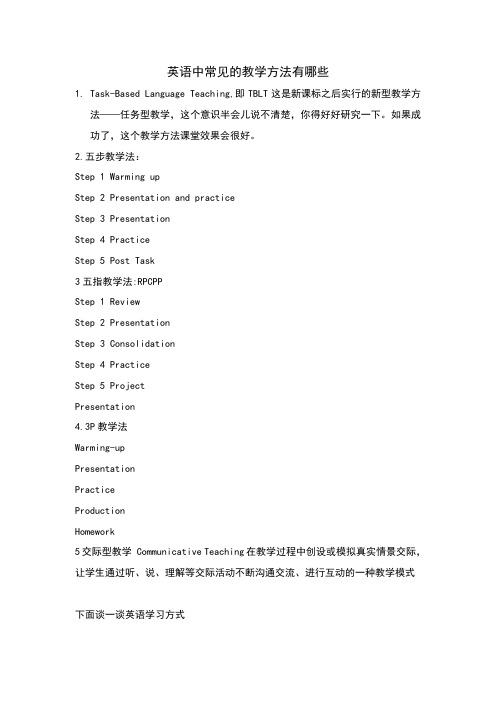
英语中常见的教学方法有哪些1.Task-Based Language Teaching,即TBLT这是新课标之后实行的新型教学方法——任务型教学,这个意识半会儿说不清楚,你得好好研究一下。
如果成功了,这个教学方法课堂效果会很好。
2.五步教学法:Step 1 Warming upStep 2 Presentation and practiceStep 3 PresentationStep 4 PracticeStep 5 Post Task3五指教学法:RPCPPStep 1 ReviewStep 2 PresentationStep 3 ConsolidationStep 4 PracticeStep 5 ProjectPresentation4.3P教学法Warming-upPresentationPracticeProductionHomework5交际型教学 Communicative Teaching在教学过程中创设或模拟真实情景交际,让学生通过听、说、理解等交际活动不断沟通交流、进行互动的一种教学模式下面谈一谈英语学习方式前面提到四种学习方式:合作学习/共同学习、自主学习、任务型学习、探究学习。
下面就对它们做一个简明扼要的介绍。
这个介绍是提纲挈领的介绍,涉及不到十分具体的技巧。
关于技巧方面可以在培训班另安排时间深入探讨。
过去(甚至目前)学生课堂学习的方式比较单一、枯燥乏味、效果不佳。
这种学习方式就是大家所熟悉的学生听教师讲为主的方式。
《英语课程标准》建议教师帮助学生掌握多种学习方式。
这里介绍的四种学习方式,不是全部的学习方式,比如,有条件的地方,可以利用多媒体手段、利用互联网络进行学习。
这里介绍四种学习方式,不意味着其他学习方式不好,或者无效,而是要根据教学实际情况选择使用、交替使用、综合使用。
而且,教师讲解也不是在教学中没有任何地位,必要的时候,仍然可以使用。
只不过不要把它作为唯一的方式或者主要的学习方式。
英语教学方法与策略
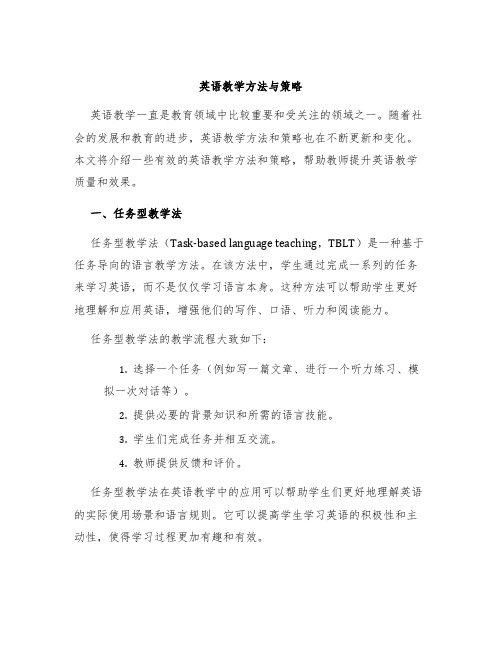
英语教学方法与策略英语教学一直是教育领域中比较重要和受关注的领域之一。
随着社会的发展和教育的进步,英语教学方法和策略也在不断更新和变化。
本文将介绍一些有效的英语教学方法和策略,帮助教师提升英语教学质量和效果。
一、任务型教学法任务型教学法(Task-based language teaching,TBLT)是一种基于任务导向的语言教学方法。
在该方法中,学生通过完成一系列的任务来学习英语,而不是仅仅学习语言本身。
这种方法可以帮助学生更好地理解和应用英语,增强他们的写作、口语、听力和阅读能力。
任务型教学法的教学流程大致如下:1.选择一个任务(例如写一篇文章、进行一个听力练习、模拟一次对话等)。
2.提供必要的背景知识和所需的语言技能。
3.学生们完成任务并相互交流。
4.教师提供反馈和评价。
任务型教学法在英语教学中的应用可以帮助学生们更好地理解英语的实际使用场景和语言规则。
它可以提高学生学习英语的积极性和主动性,使得学习过程更加有趣和有效。
二、游戏化教学游戏化教学是一种将游戏元素和教育元素相结合的教学方法。
它可以通过模拟游戏场景、增加竞争和互动,使得学习过程更加有趣和有动力。
在英语教学中,游戏化教学可以用于课堂复习、语法演练以及文化体验等方面。
以下是一些英语游戏的例子:1.Scrabble 字谜游戏:学生可以使用字母牌组成单词并获得分数。
2.英语填空游戏:学生需要填写正确的单词或词组来完成句子。
3.角色扮演游戏:学生们扮演不同的角色,模拟实际的英语交流场景。
游戏化教学可以激发学生的创造力和想象力,帮助他们更好地理解英语知识和运用语言。
此外,游戏化教学也可以提高学生的团队合作与沟通能力。
三、任务重心教学法任务重心教学法是一种强调“学生为中心”的英语教学方法。
该方法通过让学生积极参与、主动思考、独立探究等方式,帮助他们渐进地学习和应用英语知识和技能。
任务重心教学法的教学流程大致如下:1.教师设定一个任务(例如让学生自主编写一篇英语短文)。
任务型教学法英语缩写

任务型教学法英语缩写
任务型教学法英语缩写为:TBLT。
任务型教学法(Task-Based Language Teaching,TBLT)是一种以任务为中心的教学方法,旨在任务型教学法(Task-Based Language Teaching,TBLT)是一种以任务为中心的教学方法,旨在通过完成真实的语言任务来促进学生的语言学习。
该方法强调学生在交际中运用语言的能力,注重培养学生的自主学习和合作学习能力。
在任务型教学法中,教师会设计一系列与现实生活相关的任务,例如解决问题、交流信息、完成任务等。
学生需要通过与他人合作或独立完成任务来达到学习目标。
在这个过程中,学生不仅能够提高自己的语言技能,还能够培养自己的思维能力、解决问题的能力和团队合作精神。
任务型教学法的优点在于它能够激发学生的学习兴趣和积极性,提高学生的学习效果。
同时,它也能够帮助学生更好地理解和运用所学知识,从而更好地适应未来的工作和生活。
因此,任务型教学法已经成为现代英语教学中一种非常受欢迎的教学方法。
浅谈对初中英语任务型语言教学的认识与理解

浅谈对初中英语任务型语言教学的认识与理
解
首先,任务型语言教学(TBLT)主要是建立在任务为中心的英语课堂的理念上,可以促进学生更积极的参与语言学习,这也是TBLT在全世界语言教室中取得成功的最主要的原因之一。
任务可以让学生学到更加真实的语言,包括口语,阅读,写作,听力等。
其次,任务型语言教学可以让学生在掌握英语结构基础上,能够准确,高效,流利地将语言应用到实际情景中去。
任务交际可以使学生整合知识,学会解决实际情景,并培养学生的思维能力,而不是仅仅是“重复-翻译-记忆”的枯燥学习形式。
最后,任务型语言教学更加重视语言的综合能力,在任务过程中,老师也是朝着一个目标不断组织活动,教师只是学生成长过程中的起步参与者,最终学生可以从中学会如何运用知识自主地学习英语。
就此而言,任务型语言教学不仅可以促进学生更广泛,更准确,更生动的学习英语,还可以让学生掌握如何在实际情景中运用英语的能力,让他们更轻松的掌握和明白英语。
因此,任务型语言教学作为当今英语教学的一种重要的教学方法,在初中英语教学中应得到越发重视。
英语任务型教学法案例

英语任务型教学法案例IntroductionTask-based language teaching (TBLT) is an approach to second language acquisition that emphasizes language learning through the performance of tasks. TBLT has been widely studied and applied in many countries and has been shown to be an effective method for language teaching and learning. In this article, we will present a case study of TBLT in an English as a second language (ESL) classroom.The Classroom SettingThe TasksThe tasks were designed to integrate the four languageskills and provide learners with opportunities to practice using English in authentic and relevant situations. Each task was designed to be achievable, challenging, and engaging. The tasks were organized into three stages - pre-task, task cycle, and language focus - which helped to prepare learners for the task, support them during the task, and consolidate their learning after the task.Pre-taskTask CycleThe task cycle stage aimed to engage learners in the taskand provide them with opportunities to use English in authentic and meaningful ways. The tasks were designed to be open-ended, allowing learners to use their creativity and imagination. The tasks were also designed to be collaborative, encouraginglearners to work together and support each other. For e某ample, the task on describing a city required learners to work in pairs, choose a city to describe, and create a presentation using a range of media such as pictures, videos, and maps.Language FocusThe language focus stage aimed to help learners consolidate their learning and develop their language skills. The activities in this stage focused on language form, meaning, and use. The language focus activities were designed to be relevant and connected to the task. For e某ample, after the task ondescribing a city, learners were asked to reflect on thelanguage they had used and identify any grammar, vocabulary, or pronunciation areas that they needed to improve. This feedback was then used to guide the language focus activities in the ne某t lesson.ConclusionTBLT is an effective approach to language teaching and learning that emphasizes the performance of tasks. The approach provides learners with opportunities to use English in authenticand meaningful ways and helps to integrate the four language skills. The case study presented in this article demonstrates how TBLT can be effectively used in an ESL classroom to engage learners in relevant and challenging tasks, promote collaborative learning, and develop their language skills.。
高中英语任务型教学法初探TBLT在英语阅读教学中的运用

因此,教育工作者需要进一步研究和探索任务型教学法的应用和实践,以推 动高中英语阅读教学的发展和创新。
谢谢观看
六、结论
本研究表明,任务型教学法在高中英语阅读教学中具有显著优势,能够有效 地提高学生的阅读兴趣、阅读理解能力和语言表达能力。然而,在实际应用中需 要注意任务难度控制、学生参与度和教师角色转变等问题。未来研究可以进一步 探讨如何优化任务设计、提高教师教学水平以及推广任务型教学法在其他学科中 的应用等方面的问题,为高中英语阅读教学的改革与发展提供更多的参考和借鉴。
3、任务的多样性和趣味性:任务应该多样化,避免单一枯燥,同时要注重 任务的趣味性,以吸引学习者的注意力。
例如,教师可以设计一个“模拟新闻发布会”的任务,让学习者扮演新闻发 言人,回答其他学习者提出的问题。这种任务不仅锻炼了学习者的英语口语表达 能力,还培养了他们的批判性思维能力和应变能力。
(二)任务的实施
五、讨论
任务型教学法在高中英语阅读教学中的应用具有显著优势,能够有效地提高 学生的阅读兴趣、阅读理解能力和语言表达能力。然而,在实际应用中,需要注 意以下几个方面的问题:
1、任务难度:任务难度设置是任务型教学法成功的关键因素之一。任务过 于简单或过于复杂都不利于学生能力的提高。因此,教师在设计任务时需要对任 务的难度进行合理的控制,以确保学生在完成任务的过程中能够获得最大的收益。
二、任务型教学法的理论依据
任务型教学法是基于语言学习和认知心理学理论的一种教学方法。它强调学 习者在完成任务的过程中主动参与学习,通过与他人的合作和交流,发现问题、 解决问题,从而培养学习者的自主学习能力、批判性思维能力和协作能力。任务 型教学法还学习者的兴趣和需求,让学习者在真实、有意义的语境中学习英语, 从而提高学习效果。
第二语言教学法流派之间的关系

第二语言教学法流派之间的关系以第二语言教学法流派之间的关系为标题,我们将探讨不同的第二语言教学法流派以及它们之间的关系。
第二语言教学法是指在教授学习者的第二语言时所采用的不同教学方法和策略。
这些流派根据不同的理论基础和教学原则而形成,并在实践中得到不同程度的应用和发展。
下面将介绍几种常见的第二语言教学法流派以及它们之间的关系。
1. 语言交际法(Communicative Language Teaching, CLT)语言交际法是一种以语言交际为中心的教学方法,强调学习者在真实的交际环境中运用语言进行交流。
该流派关注学习者的交际能力,鼓励学习者通过真实的语言使用情境来提高语言能力。
与传统的语法翻译法相比,语言交际法注重学习者的实际运用能力,更加强调交际功能和交际策略的培养。
2. 任务型教学法(T ask-based Language Teaching, TBLT)任务型教学法是一种以任务为核心的教学方法,通过给学习者提供具体任务来促进语言学习。
该流派认为学习者通过解决真实的语言任务,能够在实践中有效地学习语言。
任务型教学法注重学习者的积极参与和合作,强调学习者在任务完成过程中的语言运用和交际能力的提高。
3. 词汇教学法(Vocabulary Teaching, VT)词汇教学法是一种专注于词汇学习和教学的教学方法。
该流派认为词汇是语言学习的基础,通过有目的地教授和练习词汇可以提高学习者的语言能力。
词汇教学法注重词汇的系统性教学和练习,通过词汇的积累和运用来促进学习者的语言发展。
4. 学习策略教学法(Learning Strategies Teaching, LST)学习策略教学法是一种强调学习者自主学习和学习策略培养的教学方法。
该流派认为学习者在学习过程中使用有效的学习策略可以提高学习效果。
学习策略教学法注重培养学习者的元认知能力和学习策略的使用,通过教授和训练学习策略来帮助学习者更好地掌握语言知识和技能。
英语教学论文范文(精选6篇)(4)

英语教学论文范文(精选6篇)(4)一、任务型教学法在初中英语课堂中的应用研究摘要:随着我国英语教学改革的不断深入,任务型教学法作为一种有效的教学方法,逐渐受到广大英语教师的关注。
本文以初中英语课堂为研究对象,探讨任务型教学法在实践中的应用及其成效。
1. 任务型教学法的概述任务型教学法(Taskbased Language Teaching,简称TBLT)是一种以任务为核心的教学模式,强调学生在完成任务的过程中自然习得语言。
这种教学法主张将语言学习与实际生活相结合,让学生在真实语境中运用英语,提高他们的语言运用能力。
2. 任务型教学法在初中英语课堂的应用实例案例一:《新目标英语》七年级上册Unit 7 “How much are these socks?”(1)任务设计:教师设计了一个“购物”任务,让学生在模拟的购物场景中运用本单元所学词汇和句型进行交流。
(2)任务实施:将学生分成若干小组,每组扮演不同的角色(顾客、售货员等)。
学生在完成任务的过程中,需要运用目标语言进行沟通,达成购物目标。
(3)任务评价:教师根据学生在任务过程中的表现,评价他们的语言运用能力、团队协作能力和问题解决能力。
3. 任务型教学法在初中英语课堂的应用成效(1)提高学生的英语学习兴趣:任务型教学法将课堂知识与实际生活相结合,使学生在轻松愉快的氛围中学习英语,增强了他们的学习兴趣。
(2)培养学生的语言运用能力:通过完成各种任务,学生将所学知识应用于实际情境,提高了他们的英语口语和听力水平。
(3)增进学生之间的合作与交流:任务型教学法强调团队合作,学生在完成任务的过程中,相互帮助、共同进步,增进了彼此间的友谊。
4. 结论任务型教学法在初中英语课堂中的应用具有显著成效,有助于提高学生的英语学习兴趣和语言运用能力。
教师在实际教学中,应根据学生的实际情况和教学内容,灵活设计任务,以充分发挥任务型教学法的优势。
二、任务型教学法在初中英语课堂中的应用策略1. 注重任务的真实性在设计任务时,教师应确保任务的真实性,使其贴近学生的生活实际。
教学方法

教源于心——教因学而生学因心而成弥勒市西山民族中学陈保艳教师的教学方法决定了课堂教学的高效与否,实施新课标后老师们使用了一些新型的英语教学法。
一、常见的几种初中英语教学法:1、任务型教学法:Task-Based Language Teaching(TBLT)2、五步教学法:Step Warming up-------Step 2 Presentation andpractice---Step3 Drill--- Step 4 practice---- Step5Consolidation3、五指教学法:Step 1 Review----Step 2 Presentation-----Step 3Consolidation----Step 4 Practice-----Step 5 Project4、3 P教学法:Step 1 Warming up----Step 2 Presentation----Step 3Production----Step 4 Homework5、交际型教学(Communicative Teaching): 在教学过程中创设或模拟真实情景交际,让学生通过听、说、理解等交际活动不断沟通交流,进行互动的一种教学模式。
尽管我们学了多种教学法,但针对不同的学生及课型,教学方法也在改变,下面,我向老师们介绍下多年来我一直在使用的教学方法,它为我的教学成绩稳固立下了汗马功劳。
那就是“目标---异步教学法”.二、目标异步教学法:1、展示目标:目标的出示就是解决“学什么”的问题。
展示目标就是把本节课的重点知识呈现,而且必须以最直接、最醒目的方式呈现。
在每节课的知识热身后,立即抓住学生上课时注意力最集中的5分钟时间介绍,讲解目标,让学生做到心中有数。
2、设置意境:根据本节课的学习目标,教师可采用多种教学手段引导学生走入英语场景(购物、问路、打电话、看病、谈论天气、饮食等等),如:多媒体、食物、幻灯,自演等,总之,教师就是我们教学所需要的一切场所。
任务型教学在初中英语教学中的应用
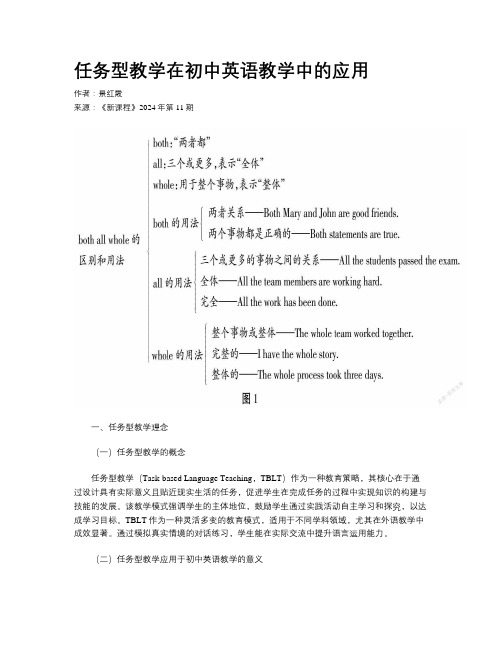
任务型教学在初中英语教学中的应用作者:景红霞来源:《新课程》2024年第11期一、任务型教学理念(一)任务型教学的概念任务型教学(Task-based Language Teaching,TBLT)作为一种教育策略,其核心在于通过设计具有实际意义且贴近现实生活的任务,促进学生在完成任务的过程中实现知识的构建与技能的发展。
该教学模式强调学生的主体地位,鼓励学生通过实践活动自主学习和探究,以达成学习目标。
TBLT作为一种灵活多变的教育模式,适用于不同学科领域,尤其在外语教学中成效显著。
通过模拟真实情境的对话练习,学生能在实际交流中提升语言运用能力。
(二)任务型教学应用于初中英语教学的意义任务型教学在初中英语教育领域的应用,能够极大地激发学生的学习动机,对学生的语言技能和整体素质的提升具有显著效果。
传统的英语教学往往侧重于语法和词汇的记忆,容易使学生感到枯燥乏味。
而在任务型教学模式下,学生通过参与设计好的任务,如角色扮演、情景对话、项目研究等,能够体验到学习的乐趣和成就感,从而提高学习英语的积极性。
任务型教学还促进了学生跨文化意识的形成。
在全球化日益加深的当今世界,了解和尊重不同文化显得尤为重要。
通过接触和探讨来自不同文化背景的任务,学生能够开阔国际视野,提高跨文化交际能力,为将来在国际舞台上的交流与合作打下良好的基础。
将任务型教学应用于初中英语教学,不仅有利于学生英语能力的提升,同时对学生个人综合素质的培养也具有重要意义。
二、任务型教学在初中英语教学中的应用策略(一)明确教学目标,引导学生自主预习“预习是成功的关键之一。
”初中英语课文涉及的新单词较多,句式也不是简单成分,学生在没有预习的前提下进行课堂学习,极大可能会出现跟不上老师的节奏、不知道老师在讲什么等问题。
虽然教师和学生都深知预习的重要性,但是部分学生存在惰性,不能自主完成没有任务的预习。
还有部分学生虽然想预习,但不清楚需要预习什么,觉得无目标的预习只是浪费时间。
任务型教学法之我见
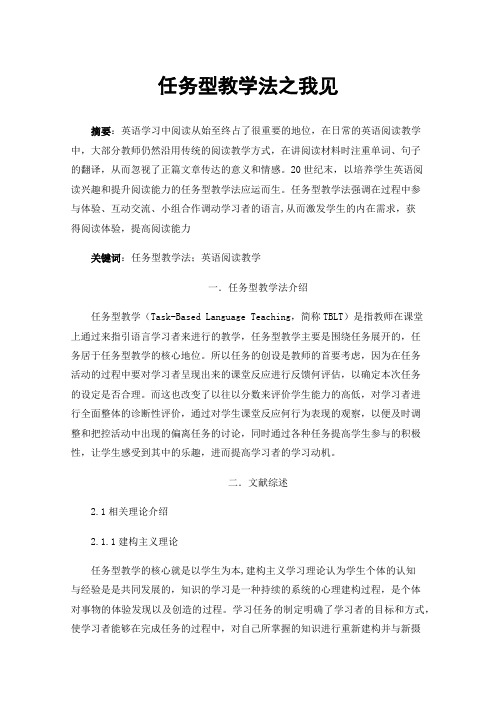
任务型教学法之我见摘要:英语学习中阅读从始至终占了很重要的地位,在日常的英语阅读教学中,大部分教师仍然沿用传统的阅读教学方式,在讲阅读材料时注重单词、句子的翻译,从而忽视了正篇文章传达的意义和情感。
20世纪末,以培养学生英语阅读兴趣和提升阅读能力的任务型教学法应运而生。
任务型教学法强调在过程中参与体验、互动交流、小组合作调动学习者的语言,从而激发学生的内在需求,获得阅读体验,提高阅读能力关键词:任务型教学法;英语阅读教学一.任务型教学法介绍任务型教学(Task-Based Language Teaching,简称TBLT)是指教师在课堂上通过来指引语言学习者来进行的教学,任务型教学主要是围绕任务展开的,任务居于任务型教学的核心地位。
所以任务的创设是教师的首要考虑,因为在任务活动的过程中要对学习者呈现出来的课堂反应进行反馈何评估,以确定本次任务的设定是否合理。
而这也改变了以往以分数来评价学生能力的高低,对学习者进行全面整体的诊断性评价,通过对学生课堂反应何行为表现的观察,以便及时调整和把控活动中出现的偏离任务的讨论,同时通过各种任务提高学生参与的积极性,让学生感受到其中的乐趣,进而提高学习者的学习动机。
二.文献综述2.1相关理论介绍2.1.1建构主义理论任务型教学的核心就是以学生为本,建构主义学习理论认为学生个体的认知与经验是是共同发展的,知识的学习是一种持续的系统的心理建构过程,是个体对事物的体验发现以及创造的过程。
学习任务的制定明确了学习者的目标和方式,使学习者能够在完成任务的过程中,对自己所掌握的知识进行重新建构并与新摄入的新知识进行认知连接,互动交融以及整合以促进语言信息的内化,实现语言习得的目标。
2.1.2二语习得理论20世纪60年代,Karshen提出了著名的“可理解性语言输入”的二语习得理论,其认为语言的输入超出了学习者目前的语,理解,掌握,运用水平时,习得就会自然而然地产生,学习在学习语言的过程中通过不断的假设修正获得新知,从而获得那些能够激活语言习得的输入信息,完成语言的学习。
任务型教学法TBLT

Task
During the task phase, the students perform the task, typically in small groups, although this is dependent on the type of activity. And unless the teacher plays a particular role in the task, then the teacher's role is typically limited to one of an observer or counselor— thus the reason for it being a more studentcentered methodology.
Analysis
•Here the focus returns to the teacher who reviews what happened in the task, in regards to language. It may include language forms that the students were using, problems that students had.
In practice
Pre-task
In the pre-task, the teacher will present what will be expected of the students in the task phase. The instructor may also present a model of the task by either doing it themselves or by presenting picture, audio, or video demonstrating the task.
vocabulary tblt教学法

vocabulary tblt教学法Vocabulary TBLT教学法TBLT(Task-Based Language Teaching,基于任务的语言教学法)是一种以任务为核心的语言教学方法。
在这种教学法中,学生通过执行真实的任务来学习语言,这样能够提高他们的语言能力和交际能力。
Vocabulary TBLT教学法则是在TBLT的基础上特别针对词汇教学而设计的一种教学方法。
Vocabulary TBLT教学法的核心理念是通过真实的任务来帮助学生掌握和应用新的词汇。
这种教学法充分考虑到学生的学习需求和兴趣,通过提供有意义的任务来激发学生的学习动机。
以下是Vocabulary TBLT教学法的一些关键要点。
1. 任务设计:任务应该有明确的目标,能够激发学生的兴趣,并且与学生的实际生活和学习经验相关。
任务可以是真实场景中的沟通活动,如讨论旅行计划、写电子邮件等。
通过执行任务,学生能够在实践中使用新的词汇。
2. 词汇选择:教师在设计任务时应选择与学生学习目标相关的词汇。
这些词汇应该是学生在实际交际中常用的词汇,能够帮助学生提高他们的交际能力。
3. 词汇教学:在执行任务之前,教师可以通过一些课堂活动来教授新的词汇。
这些活动可以包括词汇练习、词汇游戏和词汇拓展等。
教师可以使用不同的教学资源,如课本、词汇卡片和多媒体材料,以帮助学生掌握新的词汇。
4. 任务执行:在执行任务时,学生应使用他们学习到的词汇来完成任务。
教师可以提供必要的支持和指导,鼓励学生主动运用词汇进行交流。
学生可以在小组或整个班级的合作中完成任务,这样能够增加他们的互动和合作能力。
5. 反馈和评估:在任务完成后,教师应给予学生及时的反馈。
这可以是口头反馈,如对学生的表现进行评价和指导;也可以是书面反馈,如批改学生的作业。
教师还可以通过课堂讨论和小组分享的方式让学生互相评价和反馈。
Vocabulary TBLT教学法的优势在于它能够将语言学习与实际应用结合起来,帮助学生更好地掌握和运用新的词汇。
tblt教学法教案模板
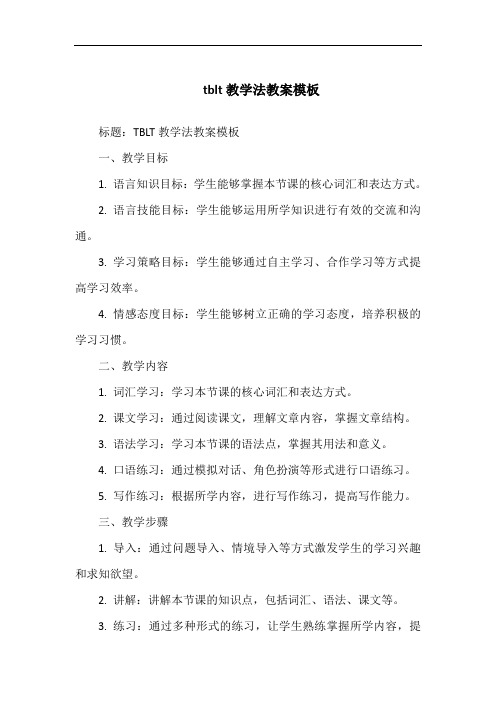
tblt教学法教案模板
标题:TBLT教学法教案模板
一、教学目标
1. 语言知识目标:学生能够掌握本节课的核心词汇和表达方式。
2. 语言技能目标:学生能够运用所学知识进行有效的交流和沟通。
3. 学习策略目标:学生能够通过自主学习、合作学习等方式提高学习效率。
4. 情感态度目标:学生能够树立正确的学习态度,培养积极的学习习惯。
二、教学内容
1. 词汇学习:学习本节课的核心词汇和表达方式。
2. 课文学习:通过阅读课文,理解文章内容,掌握文章结构。
3. 语法学习:学习本节课的语法点,掌握其用法和意义。
4. 口语练习:通过模拟对话、角色扮演等形式进行口语练习。
5. 写作练习:根据所学内容,进行写作练习,提高写作能力。
三、教学步骤
1. 导入:通过问题导入、情境导入等方式激发学生的学习兴趣和求知欲望。
2. 讲解:讲解本节课的知识点,包括词汇、语法、课文等。
3. 练习:通过多种形式的练习,让学生熟练掌握所学内容,提
高运用能力。
4. 归纳总结:对本节课所学内容进行归纳总结,加深学生对知识的理解和记忆。
5. 作业布置:布置相关作业,巩固所学知识,提高学习效果。
四、教学反思
1. 教学方法是否得当,是否能够激发学生的学习兴趣和积极性?
2. 学生是否能够掌握所学知识,并能够在实际生活中运用?
3. 本节课有哪些成功之处和不足之处?如何改进?。
任务驱动教学法 综述
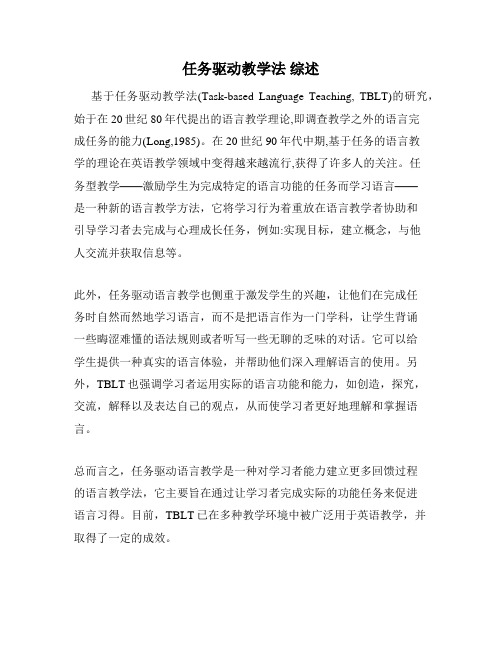
任务驱动教学法综述
基于任务驱动教学法(Task-based Language Teaching, TBLT)的研究,始于在20世纪80年代提出的语言教学理论,即调查教学之外的语言完
成任务的能力(Long,1985)。
在20世纪90年代中期,基于任务的语言教
学的理论在英语教学领域中变得越来越流行,获得了许多人的关注。
任
务型教学——激励学生为完成特定的语言功能的任务而学习语言——
是一种新的语言教学方法,它将学习行为着重放在语言教学者协助和
引导学习者去完成与心理成长任务,例如:实现目标,建立概念,与他
人交流并获取信息等。
此外,任务驱动语言教学也侧重于激发学生的兴趣,让他们在完成任
务时自然而然地学习语言,而不是把语言作为一门学科,让学生背诵
一些晦涩难懂的语法规则或者听写一些无聊的乏味的对话。
它可以给
学生提供一种真实的语言体验,并帮助他们深入理解语言的使用。
另外,TBLT也强调学习者运用实际的语言功能和能力,如创造,探究,
交流,解释以及表达自己的观点,从而使学习者更好地理解和掌握语言。
总而言之,任务驱动语言教学是一种对学习者能力建立更多回馈过程
的语言教学法,它主要旨在通过让学习者完成实际的功能任务来促进
语言习得。
目前,TBLT已在多种教学环境中被广泛用于英语教学,并
取得了一定的成效。
英语任务型教学的实践与体会

英语任务型教学的实践与体会
近年来,我一直在我的英语课堂上实践任务型语言教学(TBLT)。
通过这种教学方法,我的学生不仅增强了语言能力,还培养了批判性
思维和解决问题的能力。
TBLT方法要求教师向学生展示他们在日常生活中会遇到的真实世
界任务或问题。
这些任务可以是购物或计划假期旅行等任何事情。
任
务的主要重点不在于语言,而在于任务本身。
语言只是达成任务的工具。
这种方法有益的原因在于,它让学生接触到真实的语言使用,并
帮助他们开发功能性语言技能。
在课程中,我发现学生更加参与和积极,因为任务与他们的生活
相关。
同时,通过小组合作,他们能够锻炼协作和沟通技巧。
此外,
由于任务是开放式的,需要学生批判性思考,他们常常被挑战寻找创
造性和创新性的解决方案。
然而,实施TBLT可能会面临挑战,因为它需要认真规划和设计适
合学生的具有挑战性但可行的任务。
作为教师,必须在整个任务过程
中提供必要的支持和指导,以确保学生不会被压垮,能够成功实现任务。
总的来说,我的TBLT教学经验是积极的。
它使我能够创建一个有趣和交互式的学习环境,让学生可以有意义地应用他们的语言技能。
现代多媒体条件下tblt教学模式理据及意义
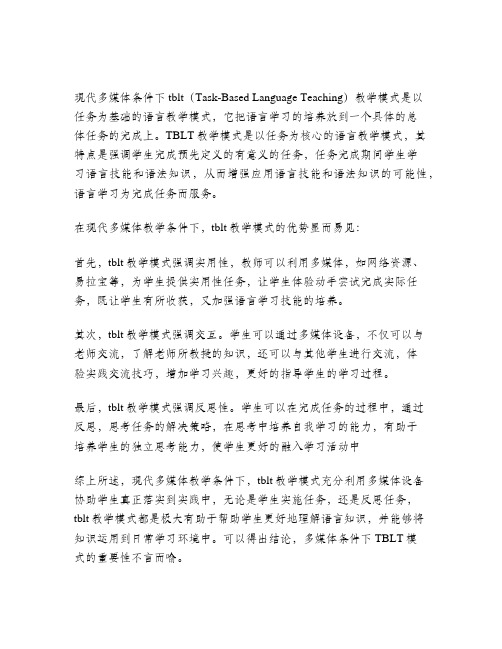
现代多媒体条件下tblt(Task-Based Language Teaching)教学模式是以
任务为基础的语言教学模式,它把语言学习的培养放到一个具体的总
体任务的完成上。
TBLT教学模式是以任务为核心的语言教学模式,其特点是强调学生完成预先定义的有意义的任务,任务完成期间学生学
习语言技能和语法知识,从而增强应用语言技能和语法知识的可能性,语言学习为完成任务而服务。
在现代多媒体教学条件下,tblt教学模式的优势显而易见:
首先,tblt教学模式强调实用性,教师可以利用多媒体,如网络资源、易拉宝等,为学生提供实用性任务,让学生体验动手尝试完成实际任务,既让学生有所收获,又加强语言学习技能的培养。
其次,tblt教学模式强调交互。
学生可以通过多媒体设备,不仅可以与老师交流,了解老师所教授的知识,还可以与其他学生进行交流,体
验实践交流技巧,增加学习兴趣,更好的指导学生的学习过程。
最后,tblt教学模式强调反思性。
学生可以在完成任务的过程中,通过反思,思考任务的解决策略,在思考中培养自我学习的能力,有助于
培养学生的独立思考能力,使学生更好的融入学习活动中
综上所述,现代多媒体教学条件下,tblt教学模式充分利用多媒体设备协助学生真正落实到实践中,无论是学生实施任务,还是反思任务,
tblt教学模式都是极大有助于帮助学生更好地理解语言知识,并能够将知识运用到日常学习环境中。
可以得出结论,多媒体条件下TBLT模
式的重要性不言而喻。
- 1、下载文档前请自行甄别文档内容的完整性,平台不提供额外的编辑、内容补充、找答案等附加服务。
- 2、"仅部分预览"的文档,不可在线预览部分如存在完整性等问题,可反馈申请退款(可完整预览的文档不适用该条件!)。
- 3、如文档侵犯您的权益,请联系客服反馈,我们会尽快为您处理(人工客服工作时间:9:00-18:30)。
Planning
Having completed the task, the students prepare either a written or oral report to present to the class. The instructor takes questions and otherwise simply monitors the students.
• Task-based language teaching (TBLT), also known as task-based language learning (TBLL) or task-based instruction (TBI) focuses on the use of authentic language and on asking students to do meaningful tasks using the target language. Such tasks can include visiting a doctor, conducting an interview, or calling customer service for help. Assessment is primarily based on task outcome (in other words the appropriate completion of tasks) rather than on accuracy of language forms. This makes TBLL especially popular for developing target language fluency and student confidence.
In practice
Report
•The students then present this information to the rest of the class. Here the teacher may provide written or oral feedback, as appropriate, and the students observing may do the same.
In practice
• The core of the lesson is, as the name suggests, the task. All parts of the language used are deemphasized during the activity itself, in order to get students to focus on the task. Here is a rather comprehensive framework suggested by Jane Willis.
Advantage
• Task-based learning is advantageous to the student because it is more student-centered, allows for more meaningful communication, and often provides for practical extra-linguistic skill building. This allows them to use all the language they know and are learning, rather than just the 'target language' of the lesson. Furthermore, as the tasks are likely to be familiar to the students , students are more likely to bg the task phase, the students perform the task, typically in small groups, although this is dependent on the type of activity. And unless the teacher plays a particular role in the task, then the teacher's role is typically limited to one of an observer or counselor— thus the reason for it being a more studentcentered methodology.
Task Based language Teaching
Outline
1 • Introduction
2 In practice
Pre-task Task Planning Report Analysis Practice
3 Advantage
4 Disadvantage
Introduction
Analysis
•Here the focus returns to the teacher who reviews what happened in the task, in regards to language. It may include language forms that the students were using, problems that students had.
Disadvantage
• There have been criticisms that task-based learning is not appropriate for beginning students. The major disadvantage for beginning students is that the focus of task-based language learning is on output, when beginning language learners often go through a silent period requiring massive amounts of comprehensible input. Others claim that students are only exposed to certain forms of language, and are being neglected of others, such as discussion or debate.
Practice
•The practice stage may be used to cover material mentioned by the teacher in the analysis stage. It is an opportunity for the teacher to emphasize key language.
In practice
Pre-task
In the pre-task, the teacher will present what will be expected of the students in the task phase. The instructor may also present a model of the task by either doing it themselves or by presenting picture, audio, or video demonstrating the task.
